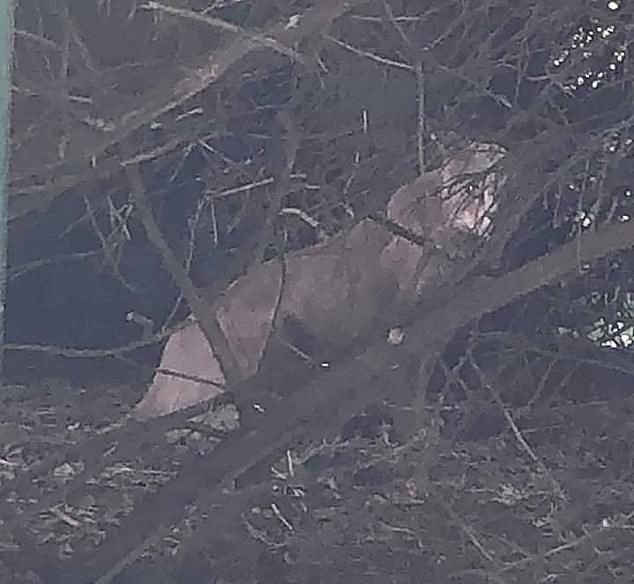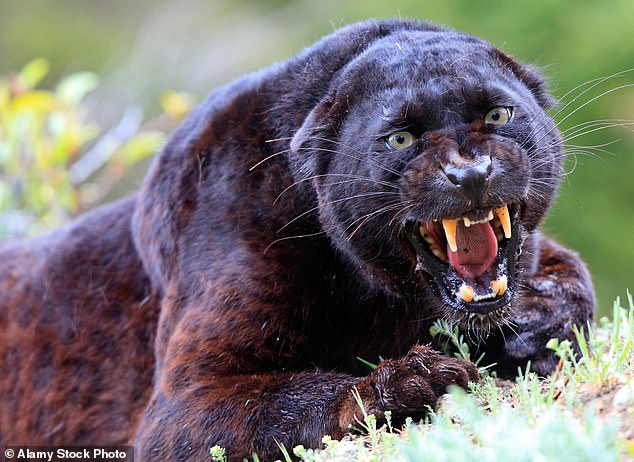There have long been rumors that big cats roam the British countryside.
Blurry photographs, large unexplained footprints and dramatic eyewitness accounts routinely add to the mystery of their existence.
But now scientists say they have found definitive evidence that a leopard prowls the Lake District, after comparing DNA found on a dead sheep with that of a non-native big cat.
Professor Robin Allaby analyzed a sample taken from the sheep’s carcass and discovered DNA from the genus Panthera, meaning it must have come from a lion, leopard, tiger, jaguar or snow leopard.
He said there was most likely a leopard on British soil and the exciting find was the first scientific evidence that non-native big cats roam the UK.
Scientists say they have found definitive evidence that a leopard prowls the Lake District, after comparing DNA found on a dead sheep with that of a non-native big cat (file image)
Biologist Professor Allaby, who said he had always had an “open mind” about the existence of big cats in Britain, told BBC Wildlife magazine that his test results left him in no doubt there was one lurking in Britain’s countryside. Cumbria.
“That makes me a convert,” he said. “In terms of odds, I think this is a real success.”
The sheep’s remains were discovered by Cumbria resident Sharon Larkin-Snowden at an undisclosed location in the highlands in October.
She disturbed what had been feeding on the carcass and the animal ran towards a stone wall before disappearing.
“I saw something black running and at first I assumed it was a sheepdog,” he said. “Then I looked at him twice and realized he was a black cat. He ran towards a stone wall, stopped and then jumped over the wall. He was big, the size of a German shepherd dog.
Larkin-Snowden took a sample from the carcass and sent it to Rick Minter, the host of the Big Cat Conversations podcast, who passed it on to Professor Allaby.
He analyzed the sample in his laboratory at the University of Warwick and discovered fox and Panthera DNA. He said the findings suggested the sheep had been eaten by both a fox and a big cat, such as a leopard.

A blurry photo, posted by a Facebook group called Big Cats in Cumbria, coincides with other alleged sightings in the countryside around Bowness-on-Windermere, in the south of the Lake District.
Professor Allaby said he was relatively certain that the sample, which only contained a small amount of DNA from a big cat, had not been faked, adding: “If this was fake, I would expect there to be enough DNA present for us to be able to be You will surely find it.
“It would be very difficult to plant just a few molecules with any finesse; I don’t think I could do it, let alone a layman.”
However, Professor Allaby said there was not enough DNA to determine exactly what type of big cat it came from.
He also said more samples were needed before he could publish a paper about his findings or say definitively that a big cat was roaming Cumbria.
But Dr. Egil Droge, a predator-prey researcher at the University of Oxford, was skeptical.
He told the BBC: “There have been no good photographs of big cats in the area, not a hint of reports of dead sheep.” I would like to see more convincing and repeated evidence.
“If a large cat were roaming around England, you would expect to see groups of dead sheep. A large cat in a small space, such as a field, with sheep, would very quickly lead to the death of many of those sheep. That would not go unnoticed.

The sheep’s remains were discovered by Cumbria resident Sharon Larkin-Snowden at an undisclosed location in the highlands in October (file image)
Big cat complaints in the UK are not a new phenomenon. The so-called Beast of Bodmin has been rumored to stalk the Cornish moors since the 1970s and a DNA test on animal hair found on barbed wire in Gloucestershire in 2022 pointed to the presence of a big cat.
And there have been many possible sightings in Cumbria since the turn of the century.
In 2015, 26-year-old hotel worker Nich Boden spoke to his local newspaper about his fears of having been hit and knocked out by a big cat while walking through Tarn Hows Wood, between Coniston and Hawkshead.
He claimed he woke up after half an hour with no memory of the attack, but had bruises, a five-inch deep cut on his left shoulder and what appeared to be four claw marks on his forearm.
“I know it’s all a bit far-fetched, but it seems very mysterious and not beyond the realms of possibility,” Mr Boden told the Westmorland Gazette.


